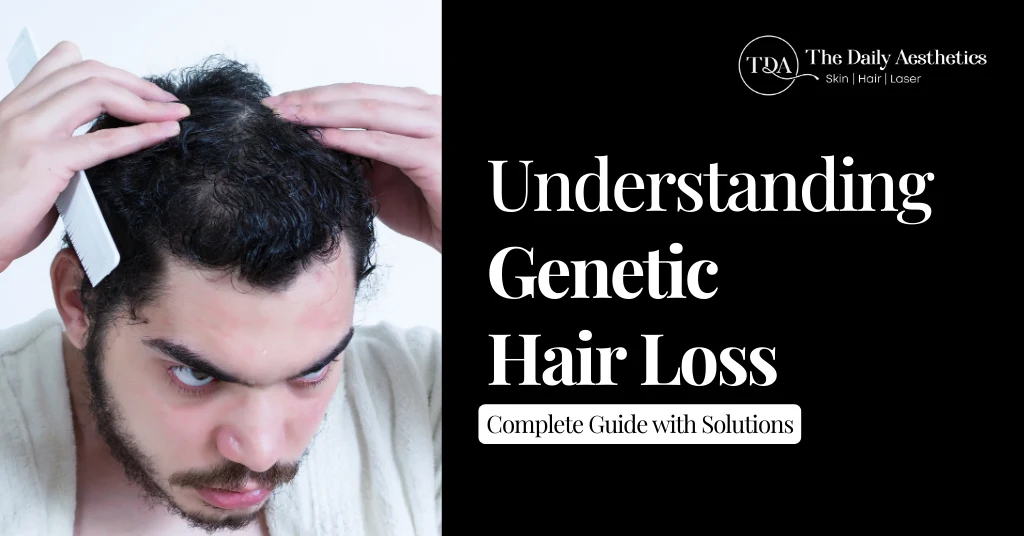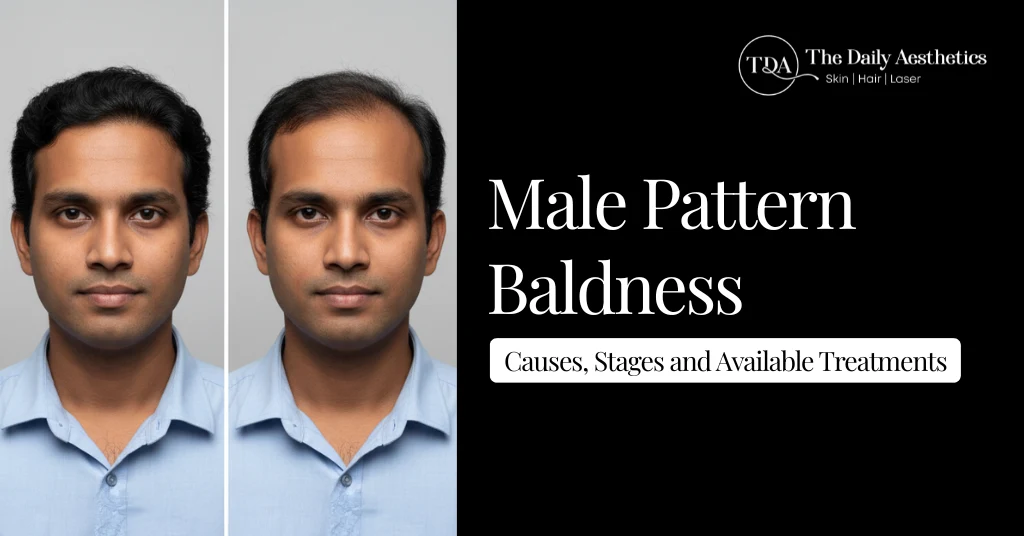The game has changed. What your parents and grandparents accepted as an inevitable consequence of “bad genetics” is now a conquerable challenge. In 2025, genetic hair loss has transformed from a life sentence to a medical condition with an impressive 85% success rate when addressed with modern treatment protocols.
If you’ve been told that thinning hair runs in your family and there’s nothing you can do about it, prepare to have that narrative completely rewritten. Today’s breakthrough therapies don’t just slow down hereditary baldness, but they can actually reverse it, giving you back not only your hair but your confidence.
This isn’t about miracle cures or empty promises. We’re talking about scientifically validated, FDA-approved solutions backed by cutting-edge research and real-world results that are changing lives every single day.
Table of Contents
ToggleWhat Is Genetic Hair Loss?
Genetic hair loss, scientifically known as androgenetic alopecia, is essentially your hair follicles’ hypersensitivity to a hormone called dihydrotestosterone (DHT). Think of DHT as a stealthy disruptor that’s been programmed by your genetic code to target specific hair follicles on your scalp.
Here’s the interesting part: this condition is responsible for a staggering 95% of all male hair loss cases. For women, the pattern differs, but the underlying mechanism remains the same, DHT gradually downsizes hair follicles until they can no longer produce the thick, healthy strands you once had.
But here’s what changes everything: your genes load the gun, but your lifestyle and treatment choices pull the trigger. You have far more control over this process than you might think.
What’s Really Happening Under Your Scalp?
Imagine your hair follicles as tiny factories that have been running smoothly for years. Then DHT shows up like a hostile takeover specialist, gradually downsizing operations until the factory can barely function.
The process unfolds in a predictable sequence:
Stage 1: The Silent Infiltration DHT molecules attach to genetically vulnerable hair follicles, triggering a cascade of inflammatory responses. You won’t notice anything, yet this is happening at the cellular level.
Stage 2: The Miniaturization Begins With each new hair growth cycle (which happens every 2-6 years), your follicles produce progressively thinner, shorter strands. What once grew as robust, pigmented hair now emerges as fine, colorless wisps.
Stage 3: The Shutdown Eventually, follicles become so miniaturized that they stop producing visible hair altogether. The area becomes smooth and shiny, what most people recognize as “balding.”
Your hair needs good blood flow to stay healthy. When hair follicles start shrinking, they get less blood. Without enough blood bringing nutrients, the follicles get even smaller and weaker. This makes it much harder for them to grow normal hair.
Why Your Hair Loss Journey Is Unique to You
Not all genetic hair loss is created equal. Two siblings with identical parents can experience completely different timelines and severity levels. Here’s why:
Genetic Lottery Variations You might inherit hair loss genes from multiple family lines, creating a “perfect storm” scenario. Alternatively, you could have protective genetic factors that slow the process significantly, even if baldness runs in your family.
Hormone Sensitivity Spectrum Your individual hormone receptors determine how aggressively DHT affects your follicles. Some people are extremely sensitive to even small amounts of DHT, while others can maintain their hair despite higher hormone levels.
Gender-Specific Manifestations Men typically develop the classic “M-shaped” hairline recession and crown thinning because these areas have the highest concentration of DHT-sensitive follicles. Women experience more diffuse thinning across the entire scalp, maintaining their hairline while losing overall density.
Timing Variables Early-onset hair loss (before age 30) often indicates higher genetic sensitivity and may progress more aggressively. Later-onset cases frequently follow a milder trajectory and respond better to intervention.
How To Detect the Warning Signs?
Catching genetic hair loss early is like detecting a small fire before it becomes a five-alarm blaze. The earlier you intervene, the more hair you can save and potentially restore.
1. Male Pattern Detection
- The Hairline Retreat Watch for subtle recession starting at the temples. This creates the characteristic “widow’s peak” appearance that gradually deepens into the classic “M” configuration. Pay attention to changes in your hairline photos over 6–12-month periods.
- Crown Vulnerability The back of your head often shows the first signs of thinning as a small, circular area where hair appears less dense. This spot expands outward in concentric circles while surrounding hair initially remains unaffected.
- Texture Transformation Before visible thinning occurs, affected areas begin producing hair with different characteristics. Strands become shorter, finer, and lose their natural color intensity essentially reverting to the soft, unpigmented hair you had as an infant.
2. Female Pattern Detection
- The Widening Part Women often first notice their part line becoming progressively wider, revealing more scalp than ever before. Areas that once provided full coverage now show visible skin underneath.
- Volume Vanishing Act Your ponytail circumference becomes noticeably smaller. Many women report needing fewer loops when securing their hair with elastic bands a surprisingly accurate early indicator.
- Overall Density Decline Unlike men’s localized balding, women experience gradual thinning throughout the scalp. Hair appears flat, lacks body during styling, and loses the natural fullness it once had.
3. Universal Red Flags
- Drain Drama Normal hair shedding ranges from 50-100 strands daily. During active hair loss phases, you might lose 150+ hairs, creating noticeable accumulation in shower drains, on pillows, or during brushing.
- Length Limitations Hair strands begin breaking or shedding before reaching their previous maximum length. This happens because weakened follicles produce structurally compromised hair that can’t withstand normal styling and environmental stresses.
- Family History Confirmation Look beyond just your parents and examine hair loss patterns in grandparents, aunts, uncles, and siblings. Genetic hair loss can skip generations and manifest differently across gender lines.
How Experts Separate Fact from Fiction?
Not all hair loss stems from genetics. Dermatologists and trichologists use sophisticated diagnostic approaches to distinguish androgenetic alopecia from other conditions with similar presentations.
- Visual Pattern Analysis Experienced professionals can identify classic genetic hair loss patterns at a glance. The specific areas affected, the progression timeline, and the hair quality changes create a distinctive signature that’s difficult to mistake.
- Dermoscopy Examination Specialized magnification reveals critical details invisible to the naked eye. Doctors can observe varying hair shaft diameters within the same area—a hallmark characteristic of follicular miniaturization caused by DHT sensitivity.
- Pull Test Assessment Gentle traction applied to different scalp regions measures active shedding rates. This simple technique determines whether hair loss exceeds normal daily amounts and helps gauge the severity of ongoing follicular disruption.
- Advanced Diagnostic Technologies Modern clinics employ digital scalp mapping systems that provide precise density measurements and tracking capabilities. Trichoscopy analysis reveals detailed follicle health status, while hormone level testing can identify contributing factors beyond genetics.
- Biopsy Procedures In complex cases where the diagnosis remains unclear, microscopic examination of scalp tissue provides definitive answers about the underlying cause of hair loss and guides appropriate treatment selection.
What Are The Other Alternatives for Hair Growth?
The landscape of genetic hair loss treatment has evolved. Today’s options range from proven pharmaceutical interventions to cutting-edge regenerative therapies that seemed like science fiction just a decade ago.
1. Pharmaceutical Powerhouses
Minoxidil: The Circulation Enhancer Originally developed as a blood pressure medication, minoxidil’s hair-growing properties were discovered as a remarkable side effect. This topical treatment works by increasing blood flow to miniaturized follicles and extending the active growth phase of the hair cycle.
Available in 2% and 5% concentrations, with higher strengths delivering superior results. Clinical studies demonstrate that 60-70% of users successfully maintain their existing hair, while 40-50% experience meaningful regrowth with consistent application over 12-18 months.
Finasteride: The DHT Blocker This prescription oral medication attacks genetic hair loss at its source by inhibiting the 5-alpha-reductase enzyme responsible for converting testosterone to DHT. By reducing systemic DHT levels by approximately 70%, finasteride allows affected follicles to recover and resume normal function.
Clinical trials show remarkable success rates, with 80-85% of male patients maintaining their hair and 65% experiencing noticeable regrowth. For women, finasteride is typically reserved for post-menopausal patients under careful medical supervision.
2. Advanced Professional Interventions
Platelet-Rich Plasma (PRP) Therapy This autologous treatment harnesses your body’s natural healing mechanisms to rejuvenate struggling hair follicles. The process involves drawing your blood, concentrating the platelets through centrifugation, then injecting the growth factor-rich plasma directly into affected scalp areas.
PRP contains numerous proteins and growth factors that stimulate cellular regeneration, improve blood supply, and extend hair growth cycles. Most patients observe improvements after 3-4 monthly sessions, with maintenance treatments every 6 months to sustain results.
Low-Level Laser Therapy (LLLT) FDA-cleared laser devices deliver specific wavelengths of red light that penetrate scalp tissue and stimulate cellular metabolism within hair follicles. This non-invasive treatment increases ATP production, enhances protein synthesis, and promotes healthier hair growth cycles.
Clinical studies demonstrate significant density improvements in both men and women, with the added benefit of being completely painless and requiring no downtime.
Microneedling Enhancement This technique creates thousands of microscopic channels in the scalp surface, dramatically improving the absorption and effectiveness of topical treatments. When combined with minoxidil or other hair growth solutions, microneedling can increase penetration by up to 40 times normal levels.
3. Surgical Hair Restoration Solutions
Follicular Unit Extraction (FUE) Modern FUE techniques involve harvesting individual hair follicles from genetically resistant donor areas and transplanting them to thinning regions. Advanced robotic systems ensure precise extraction with minimal scarring and faster recovery times.
Follicular Unit Transplantation (FUT) This method harvests a strip of scalp tissue containing multiple follicular units, allowing for maximum graft numbers in a single procedure. While it leaves a linear scar, modern closure techniques make this virtually undetectable.
Both surgical approaches achieve natural-looking results when performed by skilled practitioners who understand proper hairline design, follicle placement angles, and density distribution patterns.
Prevention Strategies: Stopping Hair Loss Before It Starts
The most effective hair loss treatment is prevention. By implementing protective strategies early, you can preserve more follicles and maintain better long-term results.
Early Intervention Advantage Starting treatment when thinning first becomes noticeable preserves significantly more follicles than waiting until advanced stages. Hair follicles that have completely miniaturized are much more difficult to revive than those just beginning to shrink.
Consistency Commitment Sporadic treatment use dramatically reduces effectiveness. Hair growth cycles span months, so consistent daily application of prescribed treatments is essential for optimal results.
Protective Daily Practices
Gentle Hair Care Protocol
- Use sulfate-free shampoos that preserve natural scalp oils
- Avoid excessive heat styling that weakens already vulnerable hair shafts
- Sleep on silk or satin pillowcases to minimize friction and breakage
- Implement gentle scalp massage techniques to improve circulation
Stress Management Integration Chronic stress elevates cortisol levels, which can accelerate hair loss and interfere with natural growth cycles. Incorporating stress reduction techniques like meditation, exercise, or counseling provides measurable hair health benefits.
Nutritional Optimization Hair follicles require specific nutrients for optimal function. Ensuring adequate intake of iron, biotin, vitamin D, zinc, and high-quality proteins supports healthy hair production and may slow genetic hair loss progression.
Professional Monitoring System Regular dermatologist evaluations allow for treatment adjustments based on response patterns and changing needs. Digital progress tracking helps identify subtle improvements that might not be immediately visible.
When to Seek Expert Intervention
The timing of your consultation can make the difference between successful treatment and missed opportunities for hair preservation.
Immediate Action Indicators Don’t wait for obvious balding to develop. Seek professional evaluation if you notice persistent increased shedding lasting more than 2-3 months, as this often indicates the beginning of active hair loss phases.
Proactive Assessment Benefits Family history alone warrants baseline evaluation, even before symptoms become apparent. Early documentation allows for precise monitoring and immediate intervention when changes begin.
Critical Warning Signs
- Rapid hairline changes occurring over weeks rather than months
- Patchy or asymmetric thinning that doesn’t follow typical genetic patterns
- Scalp inflammation, itching, or irritation accompanying hair loss
- Psychological distress affecting confidence and daily activities
- Sudden onset patterns that may indicate underlying medical conditions
Why Expert Care Makes All the Difference?
At The Daily Aesthetics Clinic, we understand that genetic hair loss isn’t just a cosmetic concern it’s a medical condition that deserves sophisticated, personalized treatment approaches.
Comprehensive Assessment Approach Our initial evaluation goes beyond surface-level observation. We conduct thorough genetic risk assessments, analyze family history patterns, and use state-of-the-art diagnostic equipment to create a complete picture of your hair loss situation.
Customized Treatment Protocols No two patients receive identical treatment plans. We combine multiple proven therapies based on your specific hair loss pattern, lifestyle requirements, genetic predisposition, and personal preferences to maximize results.
Advanced Technology Integration Our diagnostic equipment provides precise measurements and tracking capabilities that allow for objective progress monitoring throughout your treatment journey. Digital documentation captures subtle improvements that might not be immediately noticeable.
Our Distinctive Advantages
Research-Based Innovation We stay current with the latest clinical research and incorporate proven new therapies as they become available. Our practitioners regularly attend professional conferences and collaborate with leading researchers in the field.
Flexible Care Options Understanding that hair loss treatment is a long-term commitment, we offer flexible scheduling options that accommodate busy professional lifestyles. Our patient portal allows for convenient communication and progress tracking between visits.
Exceptional Success Rates Our patient satisfaction rates exceed 95%, with significant improvements in hair density, overall appearance, and confidence levels. We measure success not just in hair counts, but in how our treatments impact your quality of life.
Transform Your Hair Loss Story into a Success Story
Genetic hair loss doesn’t have to define your future. The convergence of advanced medical treatments, early detection capabilities, and personalized care approaches has revolutionized what’s possible in hair restoration.
The time to act is now. Every day you wait is another day that vulnerable follicles continue shrinking under DHT’s influence. But every day you’re on an effective treatment protocol is another step toward reclaiming the full, healthy hair you thought was lost forever.
Your genetics may have started this story, but you get to write the ending. With today’s breakthrough treatments and expert guidance, that ending can be far more positive than you ever imagined.
The Daily Aesthetics Clinic has witnessed countless transformation stories, patients who went from hiding under hats to confidently embracing their reflection. Individuals who thought their best hair days were behind them, only to discover they were actually ahead.
Don’t let genetic hair loss steal another day of your confidence. The solutions exist. Expertise is available. The only question is whether you’re ready to take the first step toward transformation.
Your hair restoration journey begins with a single decision. Make it today and start writing your success story tomorrow.
Frequently Asked Questions
1. Can genetic hair loss actually be reversed?
Yes, with early intervention and consistent treatment, most genetic hair loss can be slowed, stopped, and often partially reversed. The key is to start treatment before follicles become completely miniaturized.
2. Are modern hair loss treatments safe for long-term use?
FDA-approved treatments like minoxidil and finasteride have extensive safety profiles when used under proper medical supervision. Millions of people have used these medications safely for years.
3. How quickly will I see the results from treatment?
Initial improvements often become noticeable within 3-6 months, with optimal results typically achieved by 12-18 months. Hair growth is naturally slow, so patience and consistency are essential.
4. Can women use the same treatments as men?
Minoxidil, LLLT, and PRP therapy are suitable for both men and women. Finasteride is typically prescribed for women only after menopause due to potential effects on pregnancy.
5. Will stress make my genetic hair loss worse?
Absolutely. Chronic stress can accelerate hair shedding and negatively impact overall hair health. Managing stress through lifestyle changes can significantly improve treatment outcomes.
6. Is genetic hair loss permanent without treatment?
Unfortunately, yes. Genetic hair loss typically progresses over time and becomes permanent if left untreated. The follicles that have completely miniaturized cannot recover without intervention.
7. Can natural remedies effectively treat genetic hair loss?
While natural approaches may support overall hair health, they cannot address the underlying DHT sensitivity that drives genetic hair loss. Medical treatments remain the gold standard for meaningful results.
The Daily Aesthetics Clinic – Redefining Skin & Hair Treatments in Pune
The Daily Aesthetics Clinic is a trusted dermatology and aesthetic center in Pune, offering advanced treatments for acne, pigmentation, hair loss, laser hair removal, Hydrafacials, hair transplants, and personalized skincare.
Under the guidance of Dr. Arshi Rahul, the clinic combines medical expertise with FDA-approved technology to deliver customized treatment plans that focus on restoring skin health, enhancing radiance, and ensuring every patient feels confident and cared for.
With the trust of over 3,500 patients and a 4.9★ rating, The Daily Aesthetics Clinic is known for delivering effective, safe, and personalized care in a calm, welcoming setting.
We serve clients across Pune through our three conveniently located clinics in Baner, Kharadi, and Kalyani Nagar.
Read More
Acne vs Pimples: Understanding the Key Differences Between These Skin Conditions
Understanding Hydrafacial Treatment: Complete Guide to Process, Benefits, and Costs
Hydrafacial Price in Pune – What You Get for Your Money at The Daily Aesthetics Clinic
Dr. Arshi Rahul
Aesthetic Physician & Skin Specialist | 11+ years of experience
Expert Dermo-Cosmetologist & Trichologist (Gold Coast Training Academy, Australia) | Certified in Laser, Botox, Fillers & Thread Lifting | Over 10 Years of Advanced Aesthetic Expertise






